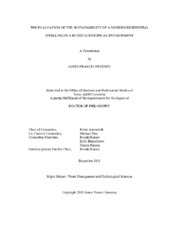| dc.contributor.advisor | Autenrieth, Robin | |
| dc.contributor.advisor | Pate, Michael B. | |
| dc.creator | Sweeney, James F | |
| dc.date.accessioned | 2016-05-04T13:20:50Z | |
| dc.date.available | 2018-12-01T07:21:34Z | |
| dc.date.created | 2015-12 | |
| dc.date.issued | 2015-12-07 | |
| dc.date.submitted | December 2015 | |
| dc.identifier.uri | https://hdl.handle.net/1969.1/156428 | |
| dc.description.abstract | The objective of this research is the life cycle analysis of a high-performance, above-code home as compared to a more traditionally built home in a humid, subtropical environment. Building energy estimations and environmental impacts analyses were performed, and model development and results were presented. Renewable energy and rainwater collection systems impacts were also investigated.
Annual operational energy was reduced 30% due to decreases in the HVAC energy associated with infiltration and building envelope differences between the
‘Reference’ and ‘As-Built’ models. Gas-based heating models embodied energies were 6% and 12% of the total energy and the use phase energy was 93% and 87% for the
‘Reference’ and ‘As-Built’ models, respectively. The embodied energy in the
‘Reference’ model was almost half of the embodied energy in the ‘As-Built’, but the
‘As-Built’ model achieved a reduction of life cycle primary energy of 23% compared to the ‘Reference’ model.
A reduction of 6,314 GJ and 402 metric tons of primary energy and GWP was achieved for the ‘Reference’ compared to the ‘As-Built’ model. Total primary energy over the life cycle was 26,216 and 19,983 GJ, with energy intensities of 44.4 and 33.8 GJ/m^2 for the ‘Reference’ and ‘As-Built’ models, respectively. The electrical-based heating models followed similar trends as the gas-based model but with a small increase in operational energy. Global warming potential had similar distribution patterns as that of the primary energy and total life cycle global warming potential intensities were estimated for the ‘Reference’ and ‘As-Built’ models, respectively as 2,835 and 2,166 kg CO2-eq/m^2.
Solar electric and hot water renewable energy systems decreased the annual operating energy by 12.5% and 15.5% and the total life cycle primary energy by 9.4% and 13.4% for the ‘Reference’ and ‘As-Built’ models, respectively. Finally, with no rainwater harvesting, total water consumption was 29.68 and 31.78 mega-liters for the ‘Reference’ and ‘As-Built’. The use phase dominates both models with 85% and 80% of the use phase for the ‘Reference’ and ‘As-Built’ model, respectively. Rainwater harvesting systems may offset the life cycle use phase and with a Monte-Carlo simulation yielded a 73% demand reduction with a 48% probability. | en |
| dc.format.mimetype | application/pdf | |
| dc.language.iso | en | |
| dc.subject | Residential Building Life Cycle Analysis | en |
| dc.subject | Lifecycle Energy Analysis | en |
| dc.subject | Lifecycle Renewable Energy Analysis | en |
| dc.subject | Lifecycle Rainwater Analysis | en |
| dc.subject | High Performance Residential Buildings | en |
| dc.subject | Low Energy Buildings | en |
| dc.subject | Building Life Cycle Impact Analysis | en |
| dc.subject | Building Primary Energy | en |
| dc.subject | Building Global Warming Potential | en |
| dc.subject | HVAC Analysis | en |
| dc.subject | Residential Renewable Energy | en |
| dc.subject | Rainwater Harvesting Systems | en |
| dc.subject | Building Simulation | en |
| dc.subject | US DOE Energy Plus | en |
| dc.subject | NREL System Advisory Model | en |
| dc.subject | Residential IECC | en |
| dc.title | The Evaluation of the Sustainability of a Modern Residential Dwelling in a Humid Subtropical Environment | en |
| dc.type | Thesis | en |
| thesis.degree.department | Civil Engineering | en |
| thesis.degree.discipline | Water Management and Hydrological Science | en |
| thesis.degree.grantor | Texas A & M University | en |
| thesis.degree.name | Doctor of Philosophy | en |
| thesis.degree.level | Doctoral | en |
| dc.contributor.committeeMember | Kaiser, Ronald | |
| dc.contributor.committeeMember | Hassan, Yassin | |
| dc.contributor.committeeMember | Brumbelow, Kelly | |
| dc.type.material | text | en |
| dc.date.updated | 2016-05-04T13:20:50Z | |
| local.embargo.terms | 2018-12-01 | |
| local.etdauthor.orcid | 0000-0001-9385-8812 | |


